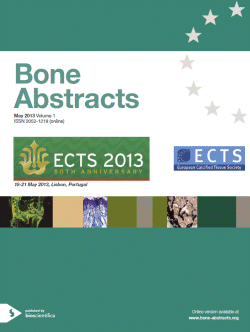Searchable abstracts of presentations at key conferences on calcified tissues

European Calcified Tissue Society Congress 2013
Lisbon,
Portugal
18 May 2013 - 22 May 2013

European Calcified Tissue Society Congress 2013, 18 - 22 May 2013; Lisbon, Portugal
Clinical Update
Clinical Update 1
ba0001cu1.1 | Clinical Update 1 | ECTS2013
Osteoporosis in premenopausal women
Osteoporosis in premenopausal is dominated by secondary causes, among which anorexia nervosa, the female athletic triad, celiac disease, and glucocorticoid-induced osteoporosis (GIO) constitute the most frequent conditions. Stress fractures of the lower extremities and low energy fractures of the ribs, are also frequent. Various genetic causes like osteogenesis imperfecta tarda are probably underdiagnosed and various inflammatory conditions also play a role. A rare, but often ...
ba0001cu1.2 | Clinical Update 1 | ECTS2013
Management of osteoporosis in pre-menopausal women
Low bone density in younger women is often due to underlying conditions such as eating disorders, premature ovarian failure or glucocorticoid treatment. It may also be due to genetically low peak bone mass.In general, absolute fracture risk in young women is low, even in the context of low bone density. Management should begin with treatment of underlying causes where possible, and lifestyle modification where appropriate.The evide...
ba0001cu1.3 | Clinical Update 1 | ECTS2013
Genetic determinants of serum sex steroids and bone health in males
Osteoporosis in men causes significant morbidity and mortality. Considerable progress has been made in understanding the pathophysiology and management of osteoporosis, though it remains under-diagnosed and under-treated, particularly in men. Osteoporosis is widely considered to be more prevalent in women, even though at least one-third of all osteoporotic fractures occur in men. A major difference between the male and the female skeleton is the larger bone dimensions in the m...
ba0001cu1.4 | Clinical Update 1 | ECTS2013
Medical management of osteoporosis in men
Awareness of osteoporosis in men is improving, although it remains under-diagnosed and under-treated. Empirical data in men display similarities with data acquired in women, despite pathophysiological differences, which may not be clinically relevant. Men should receive treatment at a similar 10 years fracture probability as in women. Bisphosphonates inhibit osteoclastic bone resorption and are the most widely used drugs in male osteoporosis. The treatment response to oral bis...
ba0001cu1.5 | Clinical Update 1 | ECTS2013
Glucocorticoid-Induced Osteoporosis
The ECTS and IOF have recently constructed a framework for the development of national guidelines for the management of glucocorticoid-induced osteoporosis in men and women aged 18 years and over in whom oral glucocorticoid therapy is considered for three months or longer. These review the epidemiology of GIO; assessment of risk utilises a fracture probability-based approach and intervention thresholds are based on 10 year probabilities using FRAX. National guidelines derived ...



